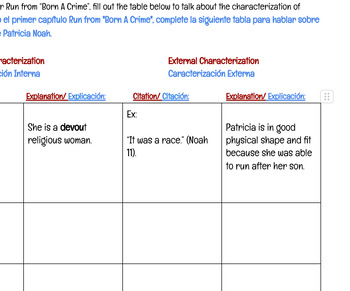Born A Crime "Run" internal/external characterization
ESLThorp
1 Follower
Grade Levels
Not Grade Specific
Subjects
Resource Type
Standards
CCSSRL.9-10.1
CCSSRL.9-10.3
CCSSRL.9-10.6
CCSSW.9-10.1
CCSSCCRA.R.1
Formats Included
- PDF
Pages
1 page
ESLThorp
1 Follower
Also included in
- Includes: -Nelson Mandala resource (could be used on a sick day or a planned absence)-Chapter One resource with characterization (bilingual: English and Spanish)-Chapter Two resource with theme exploration (bilingual: English and Spanish)-- --Assessment that includes modification and a rubric that cPrice $12.82Original Price $14.25Save $1.43
Description
This is for after reading Born A Crime chapter one, "Run".
This is for internal and external characterization with Patricia Noah with a table.
It is bilingual in both English and Spanish so helpful if teaching newcomers who need more language support. It has an example. It asks for citations and explanations. The main focus is characterization and citation work.
I included a sample answer key for the chart and there are three follow-up questions with answers in regards to the name of the chapter, the other characters, and a simile that is in the chapter.
I used this for a class with many different levels of learners. It was great for students on IEPs and in need of scaffolding and modifications.
Total Pages
1 page
Answer Key
Included
Teaching Duration
N/A
Report this resource to TPT
Reported resources will be reviewed by our team. Report this resource to let us know if this resource violates TPT’s content guidelines.
Standards
to see state-specific standards (only available in the US).
CCSSRL.9-10.1
Cite strong and thorough textual evidence to support analysis of what the text says explicitly as well as inferences drawn from the text.
CCSSRL.9-10.3
Analyze how complex characters (e.g., those with multiple or conflicting motivations) develop over the course of a text, interact with other characters, and advance the plot or develop the theme.
CCSSRL.9-10.6
Analyze a particular point of view or cultural experience reflected in a work of literature from outside the United States, drawing on a wide reading of world literature.
CCSSW.9-10.1
Write arguments to support claims in an analysis of substantive topics or texts, using valid reasoning and relevant and sufficient evidence.
CCSSCCRA.R.1
Read closely to determine what the text says explicitly and to make logical inferences from it; cite specific textual evidence when writing or speaking to support conclusions drawn from the text.



